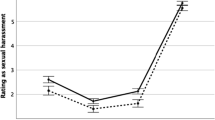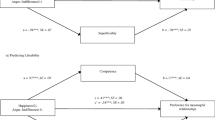Abstract
This study was designed to explore the effect of attractiveness on perceptions of sexual harassment. Male and female college students (N = 150) rated four scenarios depicting ambiguous incidents of sexual harassment, each paired with photos of a male boss and a female secretary. Male and female attractiveness was varied in a 2 × 2 factorial design. Participants were asked to rate each photo on a series of traits before making harassment judgments. Overall, females perceived more harassment. The behavior of attractive males was less likely to be seen as harassing. Attractive females were more likely to be seen as harassed, especially when the potential harasser was unattractive. The possible mechanisms underlying the effects of attractiveness were explored with the results supporting a direct effect of stereotypes over a mediating role for implicit personality theories.
Similar content being viewed by others
REFERENCES
Adams, J., Kottke, J., & Padgett, J. (1983). Sexual harassment of university students. Journal of College Student Personnel, 24, 484-490.
Ashmore, R. D., & Del Boca, F. K. (1979). Sex stereotypes and implicit personality theory: Toward a cognitive-social psychological conceptualization. Sex Roles, 5, 219-248.
Baron, R. M., & Kenny, D. A. (1986). The moderator-mediator variable distinction in social psychological research: Conceptual, strategic, and statistical considerations. Journal of Personality and Social Psychology, 51, 1173-1182.
Bruner, J., & Tagiuri, R. (1954). Person perception. In G. Lindzey (Ed.), Handbook of social psychology (pp. 634-654). Reading, MA: Addison-Wesley.
Cash, T., Gillen, B., & Burns, D. (1977). Sexism and ‘beautyism’ in personnel consultant decision making. Journal of Applied Psychology, 62, 301-310.
Castellow, W., Wuensch, K., & Moore, C. (1990). Effects of physical attractiveness on the plaintiff and defendant in sexual harassment judgments. Journal of Social Behavior and Personality, 5, 547-562.
Clifford, M., & Walster, E. (1973). The effects of physical attractiveness on teacher expectation. Sociology of Education, 46, 248.
Collins, E. G., & Blodgett, T. B. (1981). Sexual harassment...some see it...some won't. Harvard Business Review, 59, 76-95.
Dion, K., Berscheid, E., & Walster, E. (1972). What is beautiful is good. Journal of Personality and Social Psychology, 24, 285-290.
Dunning, D., & Sherman, D. (1997). Stereotypes and tacit inference. Journal of Personality and Social Psychology, 73, 459-471.
Eagly, A. H., Ashmore, R. D., Makhijani, M. G., & Longo, L. C. (1991). What is beautiful is good, but...: A meta-analytic review of research on the physical attractiveness stereotype. Psychological Bulletin, 110, 109-128.
Elkins, T. J., & Phillips, J. S. (1999). Evaluating sex discrimination claims: The mediating role of attributions. Journal of Applied Psychology, 84, 186-199.
Feingold, A. (1992). Good-looking people are not what we think. Psychological Bulletin, 111, 304-341.
Fitzgerald, L. F., & Ormerod, A. J. (1991). Perceptions of sexual harassment: The influence of gender and academic context. Psychology of Women Quarterly, 15, 281-294.
Gutek, B. A., Morasch, B., & Cohen, A. G. (1983). Interpreting social-sexual behavior in a work setting. Journal of Vocational Behavior, 22, 30-48.
Gutek, B. A., & O'Connor, M. (1995). The empirical basis for the reasonable woman standard. Journal of Social Issues, 51, 151-166.
Heilman, M. E., & Saruwatari, L. R. (1979). When beauty is beastly: The effects of appearance and sex on evaluations of job applicants for managerial and nonmanagerial jobs. Organizational Behavior and Human Decision Processes, 23, 360-372.
Hunter, C., & McClelland, K. (1991). Honoring accounts for sexual harassment: A factorial survey analysis. Sex Roles, 24, 725-752.
Kenig, S., & Ryan, J. (1986). Sex differences in level of tolerance and attribution of blame for sexual harassment on a university campus. Sex Roles, 15, 535-549.
Kenrick, D. T., Douglas, T., Neuberg, S. L., Zierk, K. L., & Krones, J. M. (1994). Evolution and social cognition: Contrast effects as a function of sex, dominance, and physical attractiveness. Personality and Social Psychology Bulletin, 20, 210.
Keppel, G. (1991). Design and analysis: A researcher's handbook. Englewood Cliffs, NJ: Prentice-Hall.
Konrad, A., & Gutek, B. (1986). Impact of work experiences on attitudes toward harassment. Administrative Science Quarterly, 21, 422-438.
Kovera, M. B., McAuliff, B.D., & Hebert, K. S. (1999). Reasoning about scientific evidence: Effects of juror gender and evidence quality on juror decisions in a hostile work environment case. Journal of Applied Psychology, 84, 362-375.
LaRocca, M. A., & Kromrey, J. D. (1999). The perception of sexual harassment in higher education: Impact of gender and attractiveness. Sex Roles, 40, 921-932.
Lewitin, S. R. (1991, November 18). Law and the unreasonable woman. National Review, 43, 34-36.
Powell, G. N. (1986). Effects of sex role identity and sex on definitions of sexual harassment. Sex Roles, 14, 9-19.
Sheets, V. L., & Braver, S. L. (1999). Organizational status and perceived sexual harassment: Detecting the mediators of a null effect. Personality and Social Psychology Bulletin, 25, 1159-1171.
Sheffey, S., & Tindale, R. S. (1992). Perceptions of sexual harassment in the workplace. Journal of Applied Social Psychology, 22, 1502-1520.
Sigelman, C. K., Thomas, D. B., Sigelman, L., & Robich, F. D. (1986). Gender, physical attractiveness, and electability: An experimental investigation of voter biases. Journal of Applied Social Psychology, 16, 229-248.
Spencer, B. A., & Taylor, G. S. (1988). Effects of facial attractiveness and gender on causal attributions of managerial performance. Sex Roles, 19, 273-285.
Studd, M. V., & Gattiker, U. E. (1991). The evolutionary psychology of sexual harassment in organizations. Ethology and Sociobiology, 249-290.
Trope, Y. (1986). Identification and inferential processes in dispositional attribution. Psychological Review, 93, 239-257.
Trope, Y., & Alfieri, T. (1997). Effortfulness and flexibility of dispositional judgment processes. Journal of Personality and Social Psychology, 73, 662-674.
U.S. Equal Employment Opportunity Commission. (1980, November). Final amendment to guidelines on discrimination because of sex under Title VII of the Civil Rights Act of 1964, as amended. 29 CFR Part 1604. Federal Register, 45, 74675-74677.
Walster, E., Aronson, V., Abrahams, D., & Rottman, L. (1966). The importance of physical attractiveness on dating behavior. Journal of Personality and Social Psychology, 4, 508-516.
Wayne, J. H., Riordan, C. M., & Thomas, K.M. (2001). Is all sexual harassment viewed the same? Mock juror decisions in same-and cross-gender cases. Journal of Applied Psychology, 86, 179-187.
Wheeler, L., & Kim, Y. (1997). What is beautiful is culturally good: The physical attractiveness stereotype has different content in collectivistic cultures. Personality and Social Psychology Bulletin, 23, 795-800.
Weiner, R. L., Hurt, L., Russell, B., Mannen, K., & Gasper, C. (1997). Perceptions of sexual harassment: The effects of gender, legal standard, and ambivalent sexism. Law and Human Behavior, 21, 71-93.
Williams, C., Brown, R., & Lees-Haley, P. (1995). An attributional (causal dimensional) analysis of perceptions of sexual harassment. Journal of Applied Social Psychology, 25, 1169-1182.
Author information
Authors and Affiliations
Rights and permissions
About this article
Cite this article
Golden, J.H., Johnson, C.A. & Lopez, R.A. Sexual Harassment in the Workplace: Exploring the Effects of Attractiveness on Perception of Harassment. Sex Roles 45, 767–784 (2001). https://doi.org/10.1023/A:1015688303023
Issue Date:
DOI: https://doi.org/10.1023/A:1015688303023




